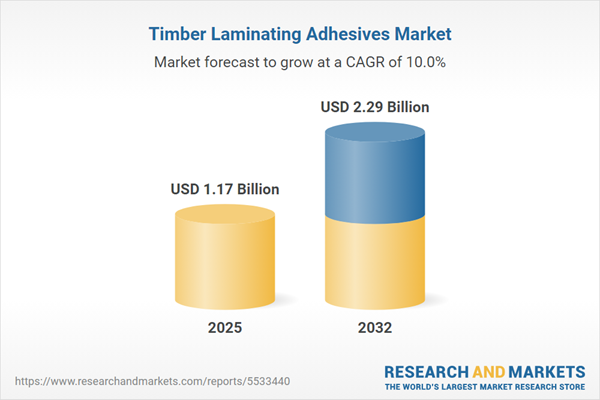Speak directly to the analyst to clarify any post sales queries you may have.
The demand for timber laminating adhesives is accelerating as engineered wood gains prominence across major industries. Senior executives are focusing on innovative formulations and regional supply chain agility to unlock growth and address sustainability imperatives in this evolving market landscape.
Timber Laminating Adhesives Market Snapshot
The timber laminating adhesives market grew from USD 1.07 billion in 2024 to USD 1.17 billion in 2025 and is projected to advance at a compound annual growth rate (CAGR) of 10%, reaching USD 2.29 billion by 2032. Expansion is driven by advancing construction methods, regulatory shifts, and the increasing adoption of engineered wood materials, making the market a focal investment area for building materials and manufacturing sectors. Stakeholders are adapting to rising requirements for durability, moisture resistance, and structural performance as sustainability and efficiency move to the forefront.
Scope & Segmentation
- End Use Industry: Construction (flooring, window frames), Furniture (kitchen cabinetry, office furniture), Marine (boat interiors, structural components), Transportation (automotive, railway)
- Resin Type: Epoxy, Melamine Formaldehyde, Phenolic, Polyurethane, Polyvinyl Acetate
- Technology: Cold Press, Hot Press, UV Cure (laser cure, microwave cure)
- Formulation: Bio Based, One Component, Two Component
- Application: Decorative Laminating (high pressure laminate, paper laminate), Edge Banding (ABS, PVC), Structural Laminating (cross laminated timber, glue laminated timber, hybrid laminated systems, laminated veneer lumber), Veneer Bonding (decorative veneer, plywood veneer)
- Region: Americas (United States, Canada, Mexico, Brazil, Argentina, Chile, Colombia, Peru), Europe, Middle East & Africa (United Kingdom, Germany, France, Russia, Italy, Spain, Netherlands, Sweden, Poland, Switzerland, United Arab Emirates, Saudi Arabia, Qatar, Turkey, Israel, South Africa, Nigeria, Egypt, Kenya), Asia-Pacific (China, India, Japan, Australia, South Korea, Indonesia, Thailand, Malaysia, Singapore, Taiwan)
- Leading Companies: Henkel AG & Co. KGaA, H.B. Fuller Company, Arkema S.A., Franklin International, Inc., Sika AG, Dow Inc., Ashland Inc., Huntsman Corporation, Hexion Inc., Jowat SE
Key Takeaways
- The adoption of bio based resins and UV cure technologies is accelerating as sustainability remains a central focus, with manufacturers innovating to meet environmental mandates.
- Supply chain decisions, particularly regarding domestic resin sourcing and manufacturing expansion, are becoming critical due to evolving tariff policies and input cost volatility.
- Digital integration is enhancing process efficiency and consistency, with real-time quality monitoring supporting lean manufacturing and reducing defects in high-volume operations.
- Segment-specific innovation—such as moisture-resistant adhesives for marine environments and lightweight bonding solutions for transportation—drives competitiveness and portfolio differentiation.
- Strategic partnerships, research collaborations, and regional footprint expansion are shaping the competitive landscape and fostering rapid development of advanced adhesive systems.
Tariff Impact on Supply Chains
Recent tariff adjustments in the United States have reshaped the supply chain environment, increasing costs for imported resin precursors and prompting industry players to emphasize domestic sourcing. These cost pressures have led to investments in local manufacturing, introducing new capital requirements and operational realignments. Downstream industries, including construction and furniture, are managing increased procurement costs and exploring alternate resin chemistries to stabilize input risks and maintain project agility. Ongoing communication between trade associations and regulatory bodies is central to balancing competitiveness and compliance across the market.
Methodology & Data Sources
This report utilizes a blend of extensive secondary research, in-depth primary interviews across the value chain, and quantitative data triangulation. Industry publications, regulatory filings, patent databases, and trade association data have been synthesized with insights from experienced adhesive technologists and industry stakeholders.
Why This Report Matters
- Provides a complete segmentation analysis to help identify targeted growth opportunities in key sectors and regions.
- Equips leaders with actionable insights on navigating regulatory, supply chain, and sustainability challenges specific to timber laminating adhesives.
- Supports strategic decision-making for product development, sourcing, and investment planning amid market transformation.
Conclusion
The timber laminating adhesives market is evolving, shaped by sustainability priorities, technology integration, and adaptive supply chain strategies. Senior leaders can leverage these insights to drive growth, resilience, and competitive advantage in a rapidly changing landscape.
Additional Product Information:
- Purchase of this report includes 1 year online access with quarterly updates.
- This report can be updated on request. Please contact our Customer Experience team using the Ask a Question widget on our website.
Table of Contents
3. Executive Summary
4. Market Overview
7. Cumulative Impact of Artificial Intelligence 2025
Companies Mentioned
The companies profiled in this Timber Laminating Adhesives market report include:- Henkel AG & Co. KGaA
- H.B. Fuller Company
- Arkema S.A.
- Franklin International, Inc.
- Sika AG
- Dow Inc.
- Ashland Inc.
- Huntsman Corporation
- Hexion Inc.
- Jowat SE
Table Information
| Report Attribute | Details |
|---|---|
| No. of Pages | 185 |
| Published | October 2025 |
| Forecast Period | 2025 - 2032 |
| Estimated Market Value ( USD | $ 1.17 Billion |
| Forecasted Market Value ( USD | $ 2.29 Billion |
| Compound Annual Growth Rate | 10.0% |
| Regions Covered | Global |
| No. of Companies Mentioned | 11 |









